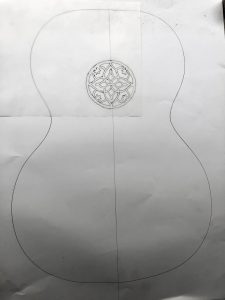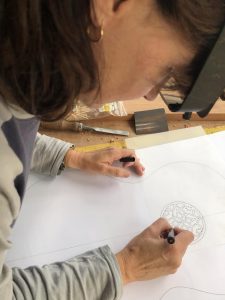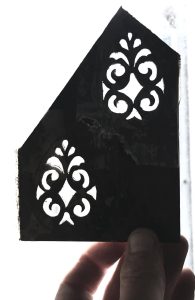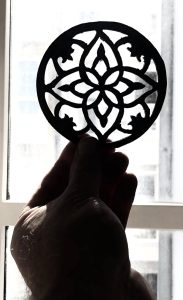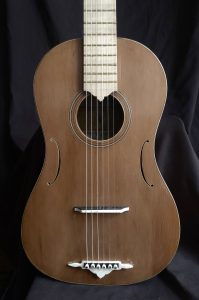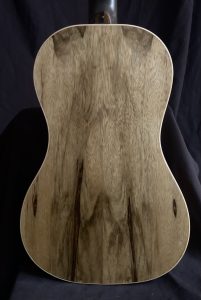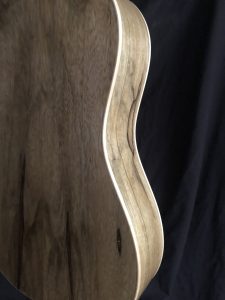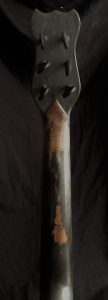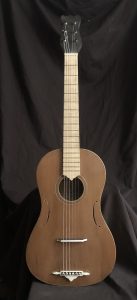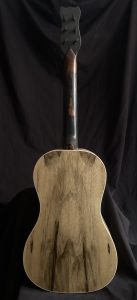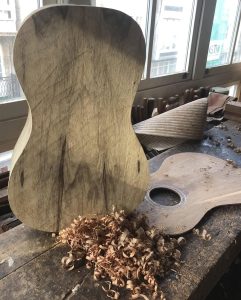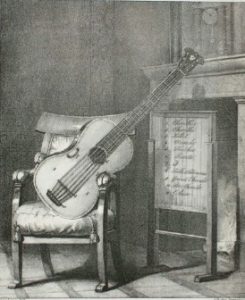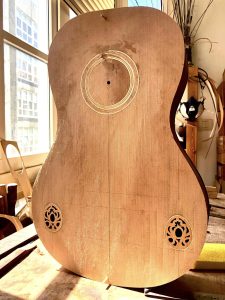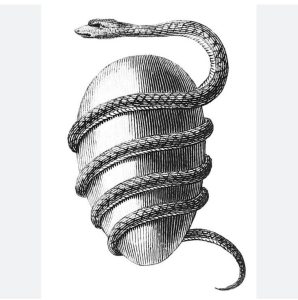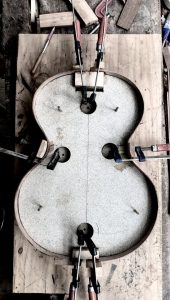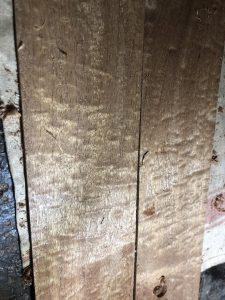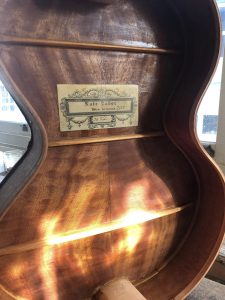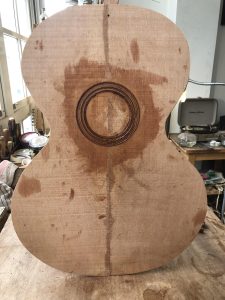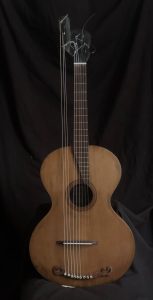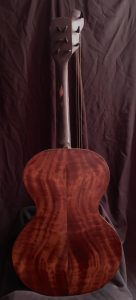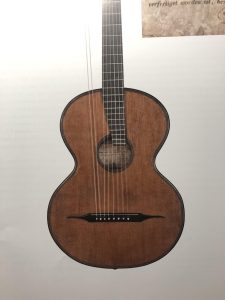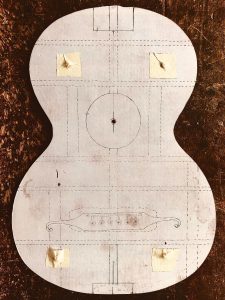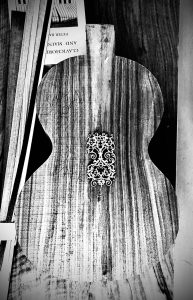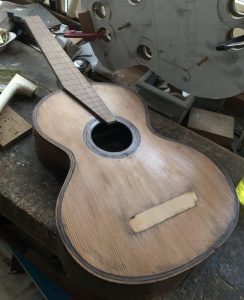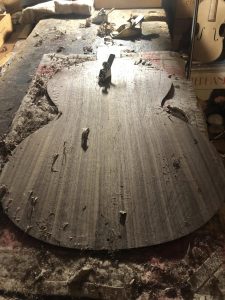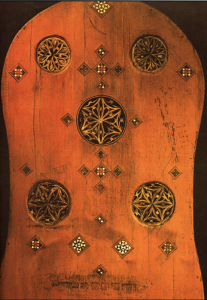I am most at home at the bench when taking risks, developing new and fanciful models based on historical examples, and crafting instruments which explore new tonal grounds. Below one may peruse the latest creations,. As one may notice with my violin-family instruments, every single guitar is a unique creation, with a new mould being made and designed by hand. My choice of wood pairings using cedar and uncommon hardwoods, are keeping in the general spirit of invention so common in the history of guitar making.
Personal Model 64cm Scale Inspired by Lacote, Stauffer.
Wider model instruments began to replace the baroque, hourglass corpus shape providing richer basses, and allowing the instrument to fit better in the lap. This personal model Romantic guitar was designed and drawn by hand, by myself, and my love, Ofelia. The unique ornaments and rossette, as well as the Sapeli/cedar pairing will prvoide a silky, mellow tone with calculated damping qualities.
Currently avaliable in paradise, A Coruña, Spain, at 4000Euro.
Fantasy Molino Model Guitar
Francesco Molino invented a new kind of guitar in the 1820s which sought to fuse features of violin family instruments into a guitar. The arched top was a totally new concept in guitar making, quite possibly paving the way for 20th C. instruments to follow. My own fantasies lead me to choose a black Limba and cedar pairing, not only as a grand experiment in line with the tradition of his innovation, but to satisfy my own personal search for sound. Available for trials with the E.U. or shipping Fed Ex world wide (SOLD)
The “EGG” aka the Fertility Guitar, Personal model. 65 scale length.
This hand-drawn personal model instrument takes the peanut shape of the late baroque as inspiration, with fairly shallow ribs for focus, but a wider corpus for more air movement in the interior. The charming Egg rosettes also help in its respiration and general projection of sound, while performing double duty as talismans for Fertility. Be forewarned that playing this instrument may lead to offspring! Currently avaliable in Spain at 4000Euro
9-String Guitar Inspired by Anton Stauffer.
This larger corpus guitar whose original model was with 8 strings, represents a shift in mid 19th C. Viennese guitar innovation when bass strings were added. One will of course notice great liberties have been taken in the tradition of experimentation, with a floating bridge which can be repositioned and thus the bass strings played similar to a Japanese Koto (!) The materials of Mahogany and Cedar are also something of a flight of fantasy, but have produced a warm, mellow but crispy tone often lacking in Maple/Spruce instruments. Currently Available in Spain at 3000 Euro.
Romantic Guitar after Johann Georg Stauffer.
The two piece perfectly and flawlessly book matched back of black walnut, (A kind gift from Jose Catoira ) Ribs from the same beautiful tree. The top of red cedar aged 30 years. This petite corpus model at 43cm has fanciful intarsia of traditional Viennese ornamentation. All details such as bracings, variations of plate thickness, and bridge reinforcements have been meticulously recreated to achieve a sweet, but penetrating tone. (SOLD )
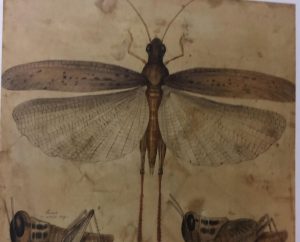
One draft of possible inlay into the walnut back
 Modern performance of Viennese music is often plagued by the malady of using large, “modern classical” instruments. While it is no secret that the great traditions of Viennese lutherie blossomed into the larger corpus guitars we are familiar with today, there is a great advantage tonally to employing a smaller bodied instrument with shallow ribs, for a sweeter, more penetrating sound, especially with vocal accompaniment.
Modern performance of Viennese music is often plagued by the malady of using large, “modern classical” instruments. While it is no secret that the great traditions of Viennese lutherie blossomed into the larger corpus guitars we are familiar with today, there is a great advantage tonally to employing a smaller bodied instrument with shallow ribs, for a sweeter, more penetrating sound, especially with vocal accompaniment.
“Diabelli published the first compositions of Franz Schubert, when he was unknown as a musical composer, and these first publications were his songs with guitar accompaniment. Schubert was a guitarist, and wrote all his vocal works with guitar in the first instance. Some few years later, when the pianoforte became more in vogue, Schubert, at the request of his publisher, Diabelli, set pianoforte accompaniments to these same songs.” – Philip Bone
Early Renaissance Guitar with features of the Guadalupe Vihuela de Mano.
A special commission for Rin Tanaka and the Kyoto Center for Culture and the Arts, this larger corpus and longer VSL experimental guitar with single strings will have a pear/cedar body with a single-piece pear neck. I am indebted to the patrons above for allowing me the freedom to invent the ornamentation inspired by early Renaissance instruments, and the unique design of the decorated head. Rin’s compositions often fuse modern and anicent instrument, merging East with West. For this project Renaissance instruments with be paired with a traditional Japanese 17 string Koto to create a series of unique Song Cycles.
Work will commence in the winter of 2026.

